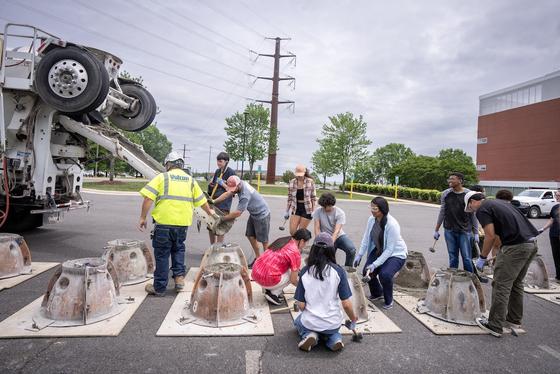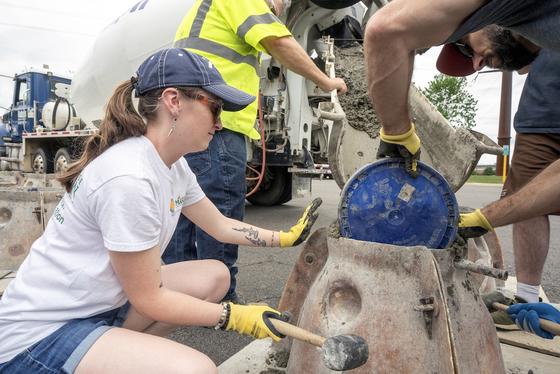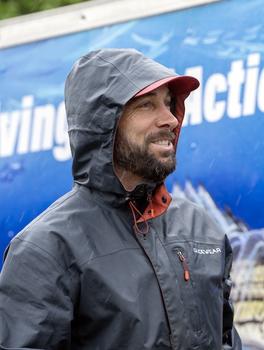Innovation and environmental stewardship are alive and well in George Mason University classrooms, where students are translating ecological science into hands-on projects.

In spring 2025, students in EVPP 480 Sustainability in Action gave a crucial boost to Chesapeake Bay oysters by constructing oyster reef balls where the bivalves can attach, grow, and develop into natural reef structures. The course is co-taught by Department of Environmental Science and Policy professors and George Mason alumni Dann Sklarew, PhD Environmental Science and Public Policy ’00, and Jennifer Sklarew, PhD Public Policy ’15.
Unlike species that rely on habitats created by others, oysters are the habitat. As a keystone species in the bay, their growth forms the foundation of reef structures that support a wide array of marine life.
“Oysters are critical to water filtration, carbon sequestration, and nutrient cycling,” said environmental science major Camille Larkin, who graduated with her bachelor’s degree in May. “Unfortunately, their populations have declined due to habitat degradation, disease, and overfishing.”
Larkin and classmates Noah Beck, BA Environmental and Sustainability Studies ’25; Erin Dougherty, BA Environmental and Sustainability Studies ’25; and Alex Peterson, BA Environmental Science ’25, worked together to develop the Chesapeake Bay Oyster Restoration Education Project, an interdisciplinary effort focused on habitat creation, environmental education, and community engagement.

With support from the Patriot Green Fund, they partnered with Coastal Conservation Association Maryland (CCA) and its flagship initiative the Living Reef Action Campaign (LRAC) to host a two-day event on George Mason’s Science and Technology Campus that brought together nearly 25 volunteers. Using molds provided by CCA, volunteers assembled the molds and assisted in the concrete pouring effort, courtesy of Vulcan Materials, to build 20 artificial reef structures, called oyster reef balls. The reef balls are approximately three feet high and weigh about 250 lbs. each.
“This project started with four students who asked, ‘Why stop at improving our campus when we could make a difference across the entire Chesapeake Bay?’” said Dann Sklarew. “The [reef balls] were designed with rough surfaces to enhance the attachment of oysters and other stationary estuarine organisms, creating habitats for fish, shellfish, and even dolphins that pass through the bay.”
Helping the volunteers was LRAC representative and George Mason alum Jesse Howe, MEd Elementary Education ’15, assistant director of CCA. Howe has been conducting these reef-building workshops throughout the Washington, D.C., metropolitan area for several years as part of his CCA advocacy work.

Howe said he was happy to hear from the students when they reached out to him about reef project. “I’ve always felt a strong connection with George Mason and was excited to be back on campus,” he said.
After graduating from George Mason, Howe taught in Latin America for nearly a decade before turning to conservation work. “This organization just really aligned with my personal values,” he said of CCA. And those teaching skills serve him well as he talks students of all ages through the steps of building the reef balls.
“It’s important work,” Howe said. “These volunteers are helping to create an ecosystem and support life in a spot of the Chesapeake Bay that has been devoid of that life for many decades.”
After the concrete structures cure for more than a year, they will be deployed at sites across the lower Potomac River and middle Chesapeake Bay and are expected to bolster oyster populations and habitat to support diverse marine life.
To extend the project’s reach, miniature versions of the reefs will be displayed on campus, alongside educational materials about oyster ecology and conservation in the Chesapeake Bay.
“We believe giving the George Mason community a hands-on role in this project builds awareness and fosters a sense of personal connection to local environmental challenges,” said Dougherty.
By combining cutting-edge scientific research with community-driven action, George Mason faculty and students are advancing reef science while realizing tangible restoration results.
Additional reporting by Colleen Kearney Rich.
Related Stories
- July 17, 2025
- July 16, 2025
- July 11, 2025
- July 10, 2025
- June 25, 2025
